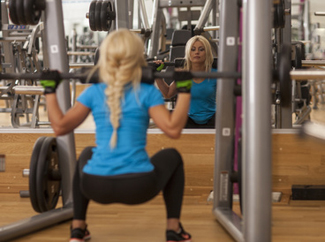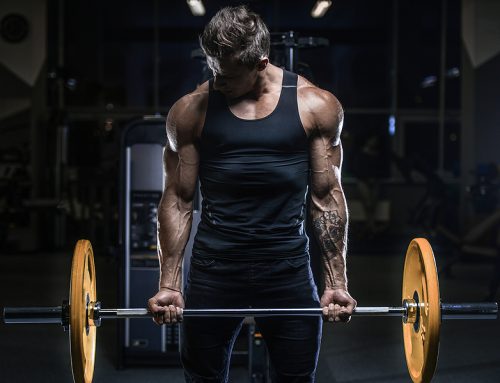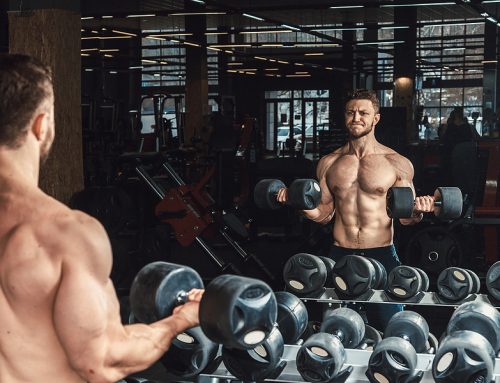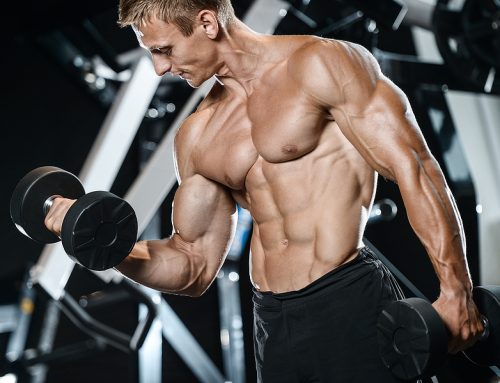“Squat in a Smith machine? Are you crazy? You might as well jump off a two story building and land on your kneecaps on the concrete below.” A trainer wrote that on a popular and “respected” bodybuilding site some years ago. And that’s the kind of nonsense about the so called dangers of machine training that’s been circulated in the fitness world ever since.
But is it true? Is the Smith machine squat really dangerous ?
Smith machines do have a few potential disadvantages that make them controversial.

On the other hand, Smith machines also have advantages that make them a viable and sometimes excellent alternative to free weight barbell squats. It’s still a squat and it’s still a great exercise. In some cases, you could even say it’s superior.
Personally, I love the Smith machine, have used it for over 30 years and have never seen anything but benefits as far as bodybuilding goes.
In this post, I’ll explain why, and at the end, I’ll even share one “secret” benefit of Smith machines that no one else talks about.
Disadvantages of Smith Machines
If you get stronger on Smith machine squats, it’s possible that might not carry over one hundred percent to improving your free weight squat, and this is often quoted as a disadvantage. Whether that matters depends on what your goals are. Is your goal is improving your free weight squat (or powerlifting) or increasing quad size for bodybuilding?
In the Smith machine, the equipment could allow you to put your body in a position or take the bar through a path that some trainers call “unnatural.” During a free weight squat, you’re forced to stay in a path according to the laws of gravity (your center of gravity stays over your feet), or else you would fall over. If the barbell slips “out of the groove,” you feel being off-kilter instantly, and that’s a cue to self-correct your form.
But whether altering the bar path or your body position on the Smith machine is beneficial or detrimental depends on your goals, body structure, the presence of pre-existing injuries and the form you use.
One of the biggest arguments against machines in general is that because balance is not required, stabilizer muscles are not developed. This may be true for some exercises. The question is, does that matter? Ironically in this case, EMG studies from the University of Saskatchewan showed that during the Smith machine squat, the stabilizers are in fact activated in the core.
What’s more, you can simply do direct ab and core work. So just because you use machines sometimes doesn’t mean you’ll have a weak core or be susceptible to injury. Plus, there’s no reason you can’t use both machines and free weights. Frankly, the argument that squats are a great way to work the abs/core, or you don’t need direct ab or core work if you train the big lifts is not very persuasive to begin with.
Some people don’t even care if certain stabilizing muscles aren’t worked as much. Bodybuilders often prefer Smith machines because they feel they can “isolate” a muscle better and get a better contraction when balancing a bar is taken out of the picture.
Take the Smith machine bench press for example. An EMG study found that one of the stabilizing muscles – the deltoid – was activated less during the Smith machine version of the exercise. On that basis, the study authors more or less concluded that free weight bench presses were superior because they activated more total muscle mass.
But guess what? The pectorals were activated in the Smith machine bench press just as much as the barbell bench press, so the claim that Smith bench press is inferior for chest activation is false. (Not to mention, the pecs are the primary target, not the deltoids).
The Smith machine squat works all the same muscles as the barbell squat. The quadriceps (front thighs) and glutes are the prime movers, and hamstrings are assisting muscles. However, a possible down side is that according to at least one EMG study, squatting in the Smith machine activates the quads significantly less than squatting with a free weight barbell.
I’m not sure whether those findings actually translate to less quad hypertrophy over time, but then again, I’m not suggesting that Smith machines build more quad muscle than barbells or that Smith machines are superior to free weights. I’m only aiming to debunk the myth that machines, including Smith machines, are dangerous or not worth using, and look at what are some advantages of doing exercises like squats in the Smith Machine.
Advantages of Smith Machines
One advantage of Smith machine squats is that they’re easier to perform. In this case, it’s because the bar moves in a fixed path along guide rods (aka “runners” or “tracks”), stabilizing the movement and removing the need for balance. This lets you concentrate on driving up with your quads and not worry about drifting forward or backward.
The Smith machine also has safety catches which can be set at the bottom, and with the hook system, you can re-rack the bar with a simple flick of the wrist at any point during a repetition. Of course you can barbell squat in a safety cage (power rack) too, but you don’t have hooks to instantly re-rack the bar.
Many bodybuilders believe that Smith machine squats with strict form are an equally or even more effective quad builder than free weight squats, or at least consider it worth alternating between the two types of squats for variety. It’s a little difficult to reconcile this observation with research findings about lesser quad muscle activation. My guess is that a trained bodybuilder with a good mind to muscle connection can direct more attention to quad contraction during Smith squats because you don’t have to direct your attention to balance and technique.
In addition, most people can lift more in a Smith machine. According to research from Drake University, experienced lifters can squat about 5% more on the machine, likely because of the reduced need for balance. Some people argue that this is another advantage. I’ve never used the Smith for max lifts, but if this means more reps at a given weight, I’ll take it.
In a Smith machine, you can squat with your feet out in front and with a variety of other body positions that you can’t with free weights. This gives the opportunity to change muscle recruitment patterns to increase stress on specific muscles and to reduce stress to specific joints. Many people consider this an advantage as well, but this is a point that even I (a fan of Smith machines) would argue could go either way.
Feet Forward Smith Squats?
Many people place their feet forward during Smith squats thinking it will make the exercise more like a hack squat, working the quads more and straining the low back less. I see this so often that I honestly wonder if a large majority of trainees think that’s the way you’re supposed to squat in a Smith machine.
This topic is widely misunderstood. Although the quads remain engaged, placing your feet forward during the Smith squat actually brings the hamstrings and glutes more into play. It may also reduce the amount of weight you can lift. If you do attempt to go heavy (and or deep) on feet-forward Smith squats, it can strain the lower back, even though your torso is more vertical.
In my experience, exaggerating the forward foot position to the point you are leaning back into the bar (like a hack squat) can create an unnatural body position that simply feels weaker and more awkward.
Putting your feet slightly forward is an acceptable variation of the Smith squat, and the machine uniquely allows you do to that, so some people add this to the “advantages” column. But I don’t believe squatting in the Smith machine with your feet far out in front is the optimal way to squat for strength or quad size. And if your goal is to activate the glutes and hams more, why not just do hip thrusts, glute bridges, Romanian deadlifts, and leg curls?
If you want a more quad dominant squat, why not simply use the hack squat machine, if it’s available? (Or at least front squats or high bar, closer stance squats). If you do decide to perform feet-forward Smith machine squats, you might consider doing them later in your leg workout, with moderate or lighter weights.
Advice: Squat in the Smith Machine With the Same Form as Your Free Weight Squats
Many people go to the Smith machine thinking it will be easier and safer on all levels. But if you do Smith machine squats with any foot and body position other than duplicating a regular back squat, I would agree it’s possible to impose unusual stresses on your joints that wouldn’t occur with free weights.
If your feet are too far back, you reduce strain on the lumbar area but increase strain on the knees. If you put your feet too far forward, you reduce strain on the knees but increase low back pain risk. These stresses are amplified the heavier you go.
In addition, while getting stronger on a Smith machine won’t necessarily translate to an improvement of your free weight squat, using the same form as you would with the barbell and free weights gives you the highest chance of carryover.
And for beginners, just learning to squat?
Since machines are considered easier in many ways, it’s common to hear people say you should learn how to squat on a Smith machine first, then later move to free weights. On the surface, that makes sense, but there’s a good argument for learning to free weight squat right from the start, especially with good coaching.
If you’ve never learned to squat with free weights, and only squat in a Smith machine, you don’t know what a natural squat is supposed to feel like, and you’re far more likely to squat in unnatural positions in the machine.
It might be wiser for beginners to do a goblet squat with a dumbbell first, (which is a great way to learn the squatting movement) then move to barbell free weights, and only then put Smith machine squats into the mix for variety.
But in the theme of this article – defending machines – the Smith machine (properly used) is an option, and there’s not a thing wrong with the leg press either. The leg press is superb for building muscle size and there is no skill or technique learning needed – all you have to do is push.
The Truth About Smith Machine Squats
It seems like Smith machines have finally been getting a little more positive press lately, at least in bodybuilding circles. But there’s still dogma circulating through the fitness community that not only are machines inferior across the board, they’re “dangerous.”
The Smith machine is one of the biggest scapegoats, yet there’s little evidence that anything is inherently bad about a Smith machine.
From the viewpoint of built-in safety features, injuries are less likely in Smith machines. Some people with a history of low back injury, myself included, find that incidence of low back pain is much lower when squatting on the Smith machine compared to with free weights.
The truth is that any exercise can cause an injury if you fail to use strict form. But most lifting injuries are preventable and shouldn’t be blamed on machines or a single exercise. Injuries are usually caused by improper technique, pre-existing structural abnormalities, lifting when fatigued, overtraining, inexperience or lack of common sense.
Wherever the misinformation about supposed dangers of Smith machines is coming from, it has led people without squat racks and Olympic barbells to ask, “If I can only squat on a Smith machine, should I skip squats completely? The answer is, of course you can do Smith machine squats! When it’s your only option, that’s one of the main reasons you’d use the machine.
This is relevant today because more than one national health club chain does not put squat racks or power racks in their gyms. (It recently came to my attention that Planet Fitness is one of them).
The key is that you have to use the Smith machine properly, just like you do every other exercise. You also need to keep your goals in mind. If your goal is bigger or more muscular quads, the Smith machine can be a great tool that’s both effective and safe.
Another Use Of the Smith Machine: Time Efficient Training In Crowded Gyms
Let me wrap up with one more advantage of Smith machines that not many people talk about: The Smith machine can be a great tool for ultra-time efficient training in crowded gyms. How? With the superset technique. All you need to do is pick two exercises that can both be done on the Smith machine and perform them back to back in superset pairs.
A great example is supersetting Smith machine squats with Smith machine calf raises. Simply place the calf block or a Reebok step inside the machine when you’re ready for the calf raises and move it out of the way for the squats. In classic bodybuilding, this is known as a staggered set (a type of superset) and it’s a genius idea for saving time, especially since these exercises don’t interfere with each other.
With a Smith machine, you can also use the fantastic antagonist superset technique. Perform your flat bench presses (for chest), then stand up and move right into a bent over row (for back).
The great thing about supersetting in a Smith machine is that it doesn’t require two machines like a squat rack and a standing calf machine. This allows you to superset even in the most crowded gym and no one gets in your way. You can potentially slash your training time in half without reducing your training volume or effectiveness.
This is one of the ultra-time efficient muscle-building techniques used in The New Body (TNB) Turbo training system, and if you’d like to learn more about this system, which you can do with either machines or free weights, at home or in a gym, CLICK HERE
Scientific References
1. Abelbeck KG, Biomechanical model and evaluation of a linear motion squat type exercise, Journal of Strength and Conditioning Research, 16(4):516-24, 2002.
2. Biscarini A, et al, Modelling the joint torques and loadings during squatting at the Smith machine, J Sports Sci. 10:1-13. 2011.
3. Biscarini A, et al, Joint Torques and Joint Reaction Forces During Squatting With a Forward or Backward Inclined Smith Machine, Journal of Applied Biomechanics, Volume: 29 Issue: 1 Pages: 85-97, 2013.
4. Cotterman et al., Comparison of muscle force production using the Smith machine and free weights for bench press and squat exercises, Journal of Strength and Conditioning Research, 19(1):169-76, 2005.
5. Schwanbeck S et al, A comparison of free weight squat to smith machine squat using electromyography. J Strength Cond. res. 23:9, 2588-2591, 2009.







Good post Tom. Smith machines absolutely have their place. However I don’t agree with your take on the decreased activation of the core stabilisers in the Smith machine. As a physio, the core activation during a squat is a key muscle activation pattern that I want to hard wire into how my body works. i.e. if I practice free weight squatting my core will learn to activate when I lift heavy stuff. Muscle activation patterns are the usual culprit with back injuries, not core power and endurance. If you squat in a Smith machine and your core doesn’t switch on then it’s less likely to switch on when you lift on other occasions, and my understand is that’s a key cause of lower back injury. You can’t train effective core muscle pre-activation by working your core in isolation.
It was the EMG study that indicated core musculature was in fact, activated during the smith squat. I suppose “activating the core” happens automatically somewhat, but I agree its important to be conscious of what this means. As I practice myself, and as I would coach others, during a squat, id recommend thinking of “bracing” the abs, as if you were going to get punched in the stomach during the descent on the squat. Beginners won’t always do this without these instructions / cues. newbies also have the idea that they have to breathe when lifting, but they often don’t understand when not to breathe. In a squat, its a big gulp of air as you descend, tighten/brace the abs/core, squat down, reverse direction, then breathe out as you stand up through the sticking point (valsalva maneuver) – its for protection as well as performance. Its my thinking that you will want to focus on this regardless of whether you are barbell squatting or smith machine squatting and not doing this is more likely the culprit in injuries rather than the machine vs barbell. Incidentally, Ive never injured my low back during a smith squat, but numerous times on a free weight squat.
Smith machine squats simply don’t work for me. I’ve tried every stance in the book, with nothing much in the way of a muscle pump. I feel greater pump with the free weight barbell
Keep doing what works best for you. barbell squats are arguably superior if you had to choose one, but Both machine squats and barbell squats can be effective. If its pump youre looking for, try: 1. continuous tension squats without locking out or stopping at the top of each rep… will blow your quads right up (though you have to use less weight) 2. superset squats with leg extensions in the 15-20 rep range – that will pump them right up too
The real bad move is squatting down to a bench. Since Smith machines are often used with a bench, I feel they have gotten a bad rap due to the fact that this is commonly done.
interesting. I never smith squatted onto a bench but was curious why you suggested its a bad move. How does that compare to a box squat with barbell, which is done often by elite lifters?